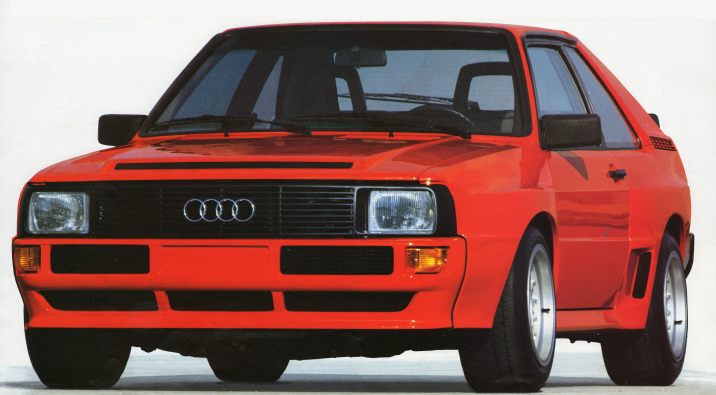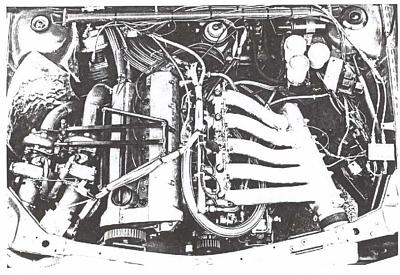Audi Sport Quattro
The fierce competition in Group B forced Audi to improve their rally cars for something more agile and competitive. As the Audi inline 5 lies far ahead of the front axle, it makes for an understeer-characteristics drivers had to battle with left foot braking, and the long wheelbase didn’t always fit the narrower twists and turns.
So to improve on this matter, Audi shortened the original Quattro wheelbase by cutting out 320 mm from the B-pillar and rearwards. The result became the Typ 859 Audi Sport Quattro, and it was manufactured from February 1984 until January 1986, with prototypes out in public since 1983.
As with the Typ 857 Quattro, intent of rallye is seen even on the road version – clear signs of being a homologation special. This uniqueness has given the Sport Quattro strong market prices 40 years later.
It’s engine is the infamous ‘KW’, Volkswagen Audi Gruppe’s first 4-valve engine, performing a healthy 306 hp / 350 Nm. It did so by a conventional throw of 86,4 mm, but a rather unique 79,3 mm bore in the world of old inline 5s. The reason was suiting with the FIA classification of engine displacement matched to the Group B turbo factor, without utilizing the high-revving short stroke configuration of motorsport vehicles.
Other noticeable changes was the use of a more upright windscreen (of the typ 81 Audi 80 2-door version) to avoid reflections, a ventilated bonnet and a one-piece grille in black surrounding the headlamps.
All chassis parts were built especially for the Sport, most of them in lightweight materials. The exception are the steel doors taken from the before-mentioned 2-door Audi 80. Hatch was in fiberglass, while the remaining panels were shaped composite weave.
It is the Quattro that introduced the 20V engine and featured fully electronic engine management with the Motronic, while the engine block is more or less the same aluminium basis as found on the rallye Quattro A1. There is the tell-tale these are prone to cracking, so it is not unusual to find a Sport Quattro featuring the more standard cast-iron block with a comment it was changed at the dealership.
If a simple way for Audi Sport to get hold of more aluminium units to campaign, is uncertain – but a genuine block swap should feature a cast iron block with transferred ‘KW’ markings or simply still being blank if done by a dealership. True or false, hard to tell, but I’ve seen the challenge first hand on such aluminium items.
Regardless of block material, the Sport Quattro is a real driver’s car, where it supersede the Quattro on mechanical features. I.e. right hand side-mirrors were optional as it stole 2 km/h of the car’s top speed, another option were competition Ronal wheels. The suspension are height adjustable coilovers struts, and the handbrake is running on a separate set of AP calipers, to allow tail happy cornering.
In street version the Sport Quattro delivers 306 hp at 6000 rpms. 0-100 km/h is done in 4.9 seconds, and top speed is around 250 km/h and the reason why the tacho now goes all the way to 300 km/h. It has a quite laggy setup, made to enable the massive K27 hybrids in competition cars. Looking at such a turbo, it is noticable its inlet port is a coned-down dimension.
All Sport Quattros features a range of regular production chassis numbers, in the format of WAUZZZ85ZEA905***. In addition, they are found with a Baur build number riveted onto the radiator support brace.

Audi Sport Quattro production numbers
With FIA holding a criteria of 200 models for Group B, and the Audi Sport Quattro was the Typ 859, it could not benefit from the homologation of the Quattro. I suppose alike other manufacturers, there are some haze to the official number from Audi.
Initially number stated was 214 Audi Sport Quattros. Due the 1988 addition of 5 cars built out of spares, I assume this makes for the current stated number of 219. 164 are reportedly sold to customers, 19 stayed in-house and 22 dedicated for Audi Sport, 5 as spare parts cars, and the remaining 6 stayed with Audi AG. If you add that up, they make for …
Many believe this includes the homologation addition for the Sport Quattro S1, which is not the true as those feature a different chassis number range.
The majority by 128 cars were painted Tornadorot, 48 cars in Alpineweiss, 21 cars in Copenhagen blau and 15 was Malachite grün. In addition 2 specials were made in black metallic, as it was Ferdinand Piech’s favourite color.
The two black can be found in old photos holding license plates IN-NJ 99 and IN-NY 88, but there are a number of repainted or rebuilt black cars around. The one Piëch kept for himself personally features additional, exclusive black details. I was so lucky to get a ride in it, and it truly is a remarkable Quattro.
Engine: inline 5, alu-block, alu-head, 20V.
Capacity: 2133 ccm by bore 79,3 mm x 86,4 mm stroke
Compression-ratio: 8.1:1
Power: 306 hp / 6000 rpms
Torque: 350 Nm / 3700 rpms
I am not familiar with the circumstances, but these images appeared on the internet some years back, revealing the Sport Quattro has been a rather interesting test bench and/or mule for different setups. In these two photos, it is apparent a Audi Sport Quattro features a highly special 25V engine, and by doing so with a bi-turbo setup of K26 turbos – probably an attempt to improve on the mid-range power band by earlier turbo spool(s) needed in rallye applications.







